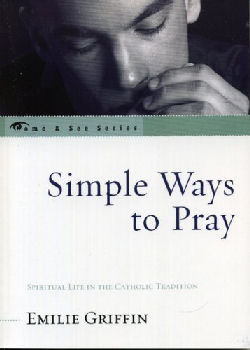
|
Posted March 31, 2006
Book: Simple Ways to Pray: Spiritual Life in the Catholic Tradition Author: Emilie Griffin Rowman and Littlefield, NY, 2006, pp. 189
In Simple Ways to Pray, Emilie Griffin explores the different types, devotional styles, and techniques of prayer and outlines practical strategies for starting and sustaining an interior spiritual life. Describing prayer as “that deep urgency or longing for something greater than ourselves,” Griffin extends an open invitation to readers to put themselves in the presence of God and, by doing so, to open their hands, minds, and hearts to receive the full potential of God’s love. This book is ideal for individual or group use in parishes and classrooms. An Excerpt from the Book: Why Should I Pray? Some questions come to mind right away. Why should I pray? What difference will it make in my life? Is prayer about asking for things? How much time should I spend? How will I find the time? Where should I pray? What if I feel awkward or strange? Is prayer a “family thing”? These and other questions will be considered. At the same time, we will look at the many and varied styles of prayer in the Catholic tradition, styles which are being richly revived today. Prayer begins as a deep urgency or longing for something beyond — something greater than ourselves – for God, even though we may not yet be able to name that longing and call it prayer. Many attempts have been made to describe prayer. Spiritual writers and teachers attempt to define — sometimes by a figure of speech or metaphor – what prayer is. Prayer has been called “a raising of the heart and mind to God” and “a long, loving look at the real.” Poets have sometimes attempted to describe prayer. The American poet Emily Dickinson wrote: Prayer is the little implement through which men reach where presence is denied them. They fling their speech by means of it in God’s ear; If then he hear this sums the apparatus comprised in prayer. As usual, she is rather witty and concise. George Herbert, an English country parson, wrote some profound spiritual poems. One gives a long list of comparisons meant to define prayer. Herbert says, for instance, that prayer is “God’s breath in man returning to his birth.” He means, I think, that prayer originates with God, who breathes into us a spirit of prayer; then we breathe it back toward God. In short, our prayer begins and ends in god. God calls us to pray, and we respond. Prayer is our response to God’s initiative. Herbert also says prayer is “the heart in pilgrimage.” Prayer is yearning of the heart, not a certain reciting of set prayer-formulas. It is genuine, sincere, heartfelt. Another phrase Herbert uses to define prayer is “the soul in paraphrase.” What on earth doe he mean? Herbert suggests that prayer transforms the soul; no longer your everyday, garden-variety soul, it has been transformed by grace. Table of Contents: Chapter 1 Opening the Treasure Box Chapter 2 Becoming Intentional Chapter 3 Visiting with Christ Jesus Chapter 4 Praying in the Holy Spirit Chapter 5 The Blessed Virgin Mary Chapter 6 Praying to angels and saints Chapter 7 Intercessory Prayer: Petition Chapter 8 Contemplative styles of Prayer: The Simpler, the Better Chapter 9 Practical Strategies Chapter 10 Spiritual Life in the Catholic Tradition |
|
